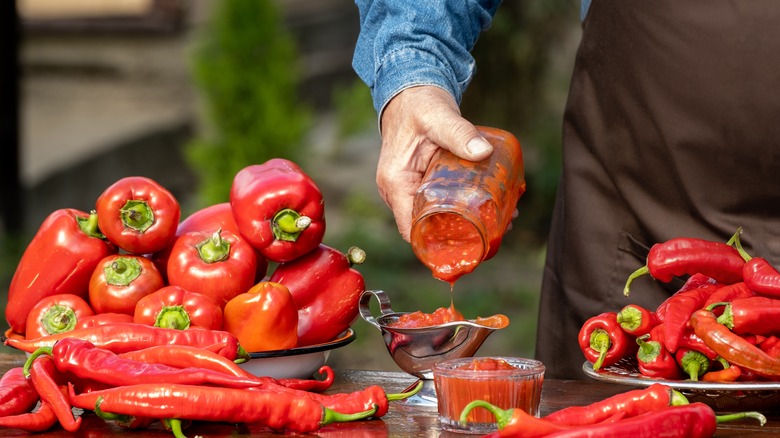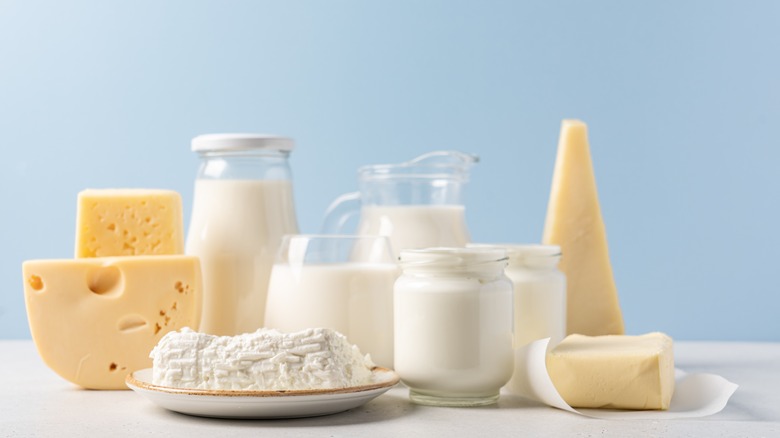The Sweet Method To Tame Food That's Too Spicy
Some people enjoy hot food — and some just like to think they do. Maybe you enjoy the heat of a chicken wing drenched in Buffalo sauce while your friend can't eat a pizza without jalapeño peppers and hot sauce. Others even enjoy trying the delicious heat of the world's spiciest foods. Everyone likes a bit of hot stuff in their food every now and then — it can keep a meal from being boring after all. A little heat never hurt nobody, whether it's wings, fried jalapeños, or roasted red peppers.
But while the McGill Office for Science and Society tells us that it's natural for different people to have different levels of spice tolerance based on how sensitive we are to capsaicin — the chemical that causes spiciness — there comes the point where the heat of your food stops being delicious and makes it plain inedible. Eating large amounts of incredibly spicy food isn't just an unpleasant experience but may also lead to painful side effects (via University Hospitals). While eating an overtly spicy dish may not put you in the hospital, it can still impact an otherwise flavorful dish.
How can you cool off a dish that has come out too spicy for your liking without ruining any natural heat and flavor?
Add something sweet to your dish
The trick to fixing an overly spicy meal involves taming the extreme spiciness and allowing it to retain its flavor without compromising it. One solution involves counterbalancing the intense heat with a few spoonfuls of something sweet.
According to Southern Living, this can easily be achieved with a small amount of sugar, which you can add in small quantities as you prepare the dish. If you find that sugar isn't working out for you, you can also use items like syrup, honey, or something similar, which will add a thicker, sweeter texture to the dish. Of course, Southern Living advises that you should be equally as careful when adding your sweeter ingredients, as adding too much could overpower other flavors in the dish.
Food Network tells us that certain sweet ingredients like sugar and honey help to absorb the capsaicin from the spice. Think of it as spreading sugar on your tongue with the sugar crystals collecting the capsaicin and removing the intense heat on your taste buds. Using sugars also adds a much richer flavor to your dish, giving a sweet, almost refreshing aftertaste following the hot bold flavors that take centerstage.
You can also add some dairy to the dish
Chances are, if you've ever bitten off more than you could chew when eating spicy foods, you'll hear someone tell you that you should be drinking a glass of milk instead of water. While you're probably too busy dealing with the burning sensation on your lips to question such a choice, you may find that a glass of ice-cold milk does, in fact, do the trick. Milk works so well in taking care of spicy residue because it contains a protein known as casein.
As Cleveland Clinic explains, this protein helps "... break down capsaicin — much in the same way that dish soap can cut through grease." While milk can clean out your mouth, water simply moves the oily capsaicin molecules around your mouth, spreading the heat rather than washing it away. This unique property of dairy makes it a good choice when trying to cut down on overly spicy meals. While you may not be willing to empty a jug of milk into your bowl of chili or stir-fry to cool it off, the Dairy Discovery Zone suggests that ingredients such as blue cheese, Greek yogurt, or cottage cheese can help provide a creamy and refreshing tang to your meal without turning it into a soupy mess.
If you add dairy to your dish, you can make anything from a light cucumber yogurt sauce to a blue cheese dressing.


